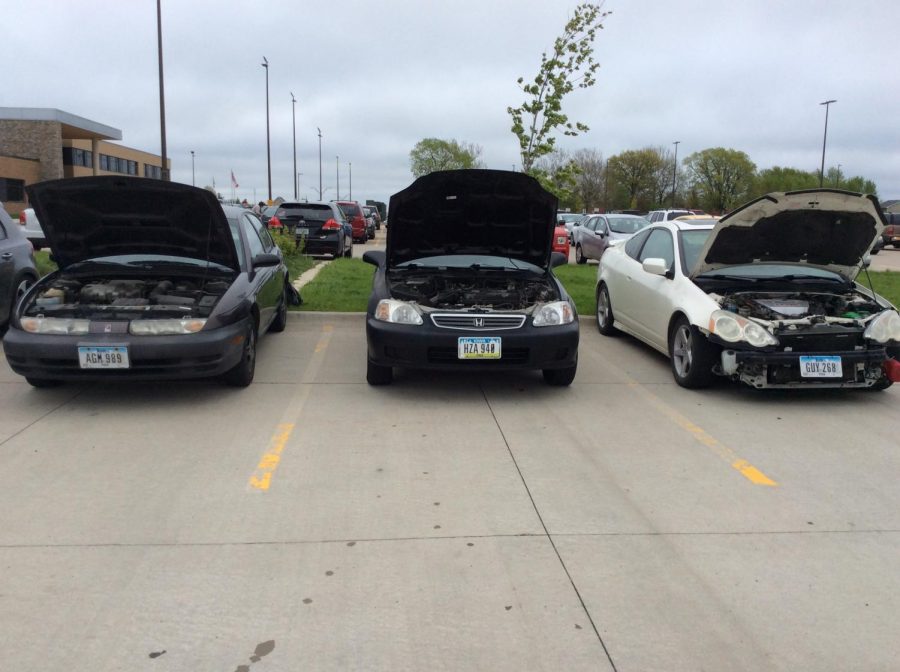Are cars with manual transmissions still relevant?
Three cars owned by students with manual transmissions are all 10 to 20 years old as manuals are harder to find now.
May 10, 2019
Cars have existed for over 100 years, and until recent decades, the majority of cars came standard with a manual transmission. Even up until 25 years ago, learning how to drive manual was required to pass drivers ed. In recent years however, automatic transmission vehicles are becoming more and more common and learning how to drive manual cars is not even talked about in drivers ed. Finding a new model car that comes with a manual transmission is harder and harder, as they just are not made nearly as much as they used to be. Sports cars and long haul truckers are some of the most common vehicles to still be manufactured with stick shifts, but even these vehicles are more commonly made with automatic transmissions. Despite this, there are still companies that produce vehicles with manual transmissions.
There are pros and cons to all different types of cars and engines, manual and automatic transmissions are no exception.
Pros of manuals are:
- They are cheaper than their automatic counterparts.
- With proper experience, manuals give drivers more control of their speed and performance on the road.
- In harsh road conditions drivers can keep better control of their cars.
- Manual transmissions are made with less parts and no computer, so it doesn’t need and electricity to work, and is cheaper to fix than a broken automatic transmission .
- Drivers can easily maintain speed when going downhill without riding the brakes.
- Manual transmissions generally last longer than automatic transmissions
Cons of manuals are:
- Takes more skill to drive
- They are hard to find
Pros of automatics are:
- They are easy to drive
- Automatics are easy to find
- There are many other engine options with automatics
Cons of automatics are:
- They are more expensive.
- They are made with more parts and take energy from the car
- They give less control to drivers
Besides being easy to drive, automatic transmissions do not have a lot going for them, but their popularity continues to grow. Some of the most common vehicles to still be made with stick shifts are semi trucks. Nearly all trucking companies supply their workers with manual semis, and while automatic semis exist, they are currently far less common than manuals.
If a driver knows how to drive a manual then they know how to drive an automatic, so truck drivers are still taught how to drive using manuals, and will most likely use manuals most of the time for their work. Scott Carnahan has been a truck driver for 26 years, and has driven both manuals and automatics throughout his career and highly prefers manual trucks as opposed to automatics. “I like manuals for winter driving better especially,” Carnahan said. “Automatic transmissions with traction control and stuff, the computer takes over so well that with an automatic you can’t tell if you’re losing traction so you try and go faster. With a manual as soon as you lose traction you feel that and know how fast you wanna go.”
Manual transmissions are also better for truck drivers when they have to reverse. When unloading cargo from trailers, drivers always have to back the trailer up to do so and with a manual going in reverse will control the same as driving forward. However semis with automatic transmissions have a hill assist feature that keeps the truck from rolling backwards down hills but because of this feature, driving in reverse is more difficult and the truck starts off backwards very slowly, so drivers who don’t normally drive with hill assist will give it more gas, causing the truck to jerk backwards and most likely result in damage or injury.
Automatic semis are in production and slowly on the rise. There is a shortage of truck drivers and trucking companies may turn to more automatics in order to attract more drivers and meet demands, but as it stands semis are some of the most common vehicles still produced with stick shifts.
Other than work vehicles and daily vehicles, sport and race cars are still made with manual transmissions as well. When it comes to racing there is drag racing, road course, autocross, and drifting. Drag racing is the only kind of race where automatics are superior to manuals, on a straight road with no turns automatics are always faster because a well built automatic shifts faster than a manual. When doing any other kind of race; road course, autocross, or drifting a manual car is better because the driver can always control the gear they are in when going around corners while an automatic will not always drop to the right gear when turning and may be too high or low and slow the driver down.
Different racers have different types of racing that they are passionate about, and nearly all different racers have a different opinion on the best cars and some even prefer to race in automatics. Classic sports cars that are now produced as automatics, such as Chargers or Mustangs or Challengers, do receive hate though as there is a popular opinion among car enthusiasts that classic cars produced in automatic are not real sports cars and do not have the same feel or performance as if they were produced manual.
My brother, Jesse Tomlinson, has been a mechanic for about five years and racing cars for seven years since he was 18, he is trained and able to work on both types of transmissions but manuals and automatics need different work. “There is no computer to control it, no wiring aside from speed sensors and maybe a position sensor,” Tomlinson said. “Internally, it’s very simple just gears and syncs and shift forks to put it very generally.” With less parts and no computer that also makes less work if the transmission breaks. “Depends on what breaks, but usually a manual is a little easier to repair,” Tomlinson said.
Whenever Tomlinson races he uses a manual car even during drag races. For his daily vehicle he does not care what kind of transmission it has but when he is racing, “I like to be more involved in the driving experience” Tomlinson said.
When I learned how to drive I was taught in a manual car because that was the only car we had at the time. After driving both manuals and automatics the manual was harder to learn and took longer to get the hang of. If I did not give the car enough gas when it was in first gear, I would kill the car, which means that it automatically shuts off even with the key turned in the ignition. I killed the car a lot the first few day and I also struggled with grinding the gears which happens when I try to shift gears but the clutch is not pushed down all the way. However after a few weeks, I got the hang of how to properly drive a manual, and after a year of only driving a manual I find it just as easy to drive as an automatic.
Vernon Bohall 20’ taught himself how to drive stick shift when because he got a manual transmission car. “I prefer it because it makes you more aware of what you are doing on the road” Bohall said.
Most people these days prefer do drive automatic cars and only know how to drive automatic, but with manual transmissions still being used and drivers who prefer them, manuals will never fully be removed from the car market and will continue to have a relevant place on the roads.
















Collin • Jul 7, 2020 at 10:27 am
Nice article man! Thanks